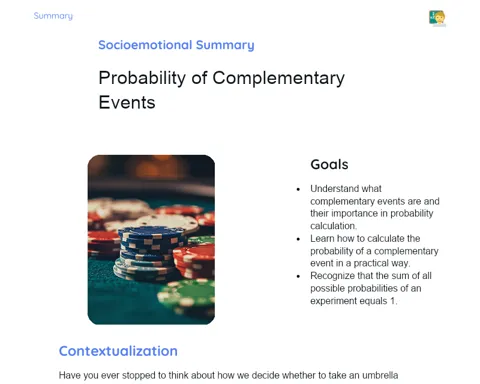Angles: Clocks | Active Summary
Objectives
1. 🕒 Understand and calculate the angle formed between the hour and minute hands at different times, using concepts of trigonometry and geometry.
2. 🔍 Develop practical skills to apply mathematical concepts in interpreting times on analog clocks, enhancing your ability to solve everyday problems.
Contextualization
Did you know that mechanical analog clocks with hands were invented more than 700 years ago? Before that, people used sundials to measure time during the day. The invention of mechanical clocks was a milestone in human history, as it allowed for precise measurement of time, which is crucial in many aspects of modern life. Today, understanding how clock hands move and how to calculate the angles between them is not just a mathematical skill, but also an essential tool for managing our time efficiently.
Important Topics
Hour Hand
The hour hand on an analog clock is the shorter hand that points at the numbers representing the hours. This hand moves more slowly than the minute hand, completing one rotation every 12 hours. Understanding how the hour hand moves relative to the minute hand is crucial for calculating the angle between them.
-
Completes a full rotation every 12 hours.
-
Moves more slowly than the minute hand.
-
Helps indicate the exact hour by aligning with or nearing an integer when the minutes are 0, 15, 30, or 45.
Minute Hand
The minute hand on an analog clock is longer than the hour hand and is responsible for indicating the minutes. It completes one rotation every 60 minutes. The speed at which this hand moves relative to the hour hand is crucial for determining the angle they form.
-
Completes a full rotation every 60 minutes.
-
Moves more quickly than the hour hand.
-
Generally has a different shape than the hour hand to aid in distinction.
Angle Calculation
To calculate the angle between the minute and hour hands, we use the concept of time proportion. We consider that in 60 minutes, the minute hand covers 360 degrees, which allows us to calculate how much it moves in a given number of minutes. Next, we calculate the movement of the hour hand, which covers 30 degrees in one hour (360 degrees divided by 12 hours). The difference between the movements of the hands gives us the angle between them.
-
The minute hand moves 6 degrees per minute (360 degrees divided by 60 minutes).
-
The hour hand moves 0.5 degrees per minute (30 degrees divided by 60 minutes).
-
The angle between the hands is the difference between the two movements. For times that are not full hours, we also consider the additional adjustment based on minutes.
Key Terms
-
Angle: The figure formed by two lines that originate from the same point, known as the vertex.
-
Analog Clock: A type of clock that visually represents time through hands on a circular face.
-
Time Proportion: The concept that the movement of a hand on a clock is proportional to the time elapsed, facilitating the calculation of angles.
To Reflect
-
How can accuracy in reading angles on an analog clock impact your daily routine?
-
In what ways can understanding the angles formed by clock hands be applied in other contexts of life?
-
What challenges have you faced in trying to calculate angles on clocks, and how did you overcome those challenges?
Important Conclusions
-
During our lesson, we explored how to calculate the angles formed between the hour and minute hands on analog clocks. We saw that the hour hand moves more slowly, completing one rotation every 12 hours, while the minute hand moves faster, completing one rotation every 60 minutes.
-
Understanding these movements and applying concepts of trigonometry and time proportion allows us to accurately calculate the angle between the hands, a useful and practical skill in everyday life for interpreting times on analog clocks.
-
Mathematics is present in many aspects of our lives, and the ability to calculate angles on clocks is just one example of how mathematical knowledge can be applied in real situations, helping us to be more efficient and organized.
To Exercise Knowledge
Create a time diary for one week. Note all the times you look at an analog clock and calculate the angle formed between the hour and minute hands. Try to identify patterns or moments when the angle is easier or more challenging to calculate.
Challenge
Rapid Clock Challenge: Time how long it takes you to calculate the angle between the clock hands at different times throughout the day. Try to improve your calculation speed each day and see how fast you can become!
Study Tips
-
Practice regularly calculating angles on analog clocks, trying to visualize the movements of the hands in your mind to improve your accuracy and speed.
-
Use analog clock applications on your phone or computer to test your knowledge and angle calculation skills in an interactive and fun way.
-
Discuss with friends or family how they calculate angles on analog clocks and compare different methods and strategies, enriching your understanding and approach to the topic.



